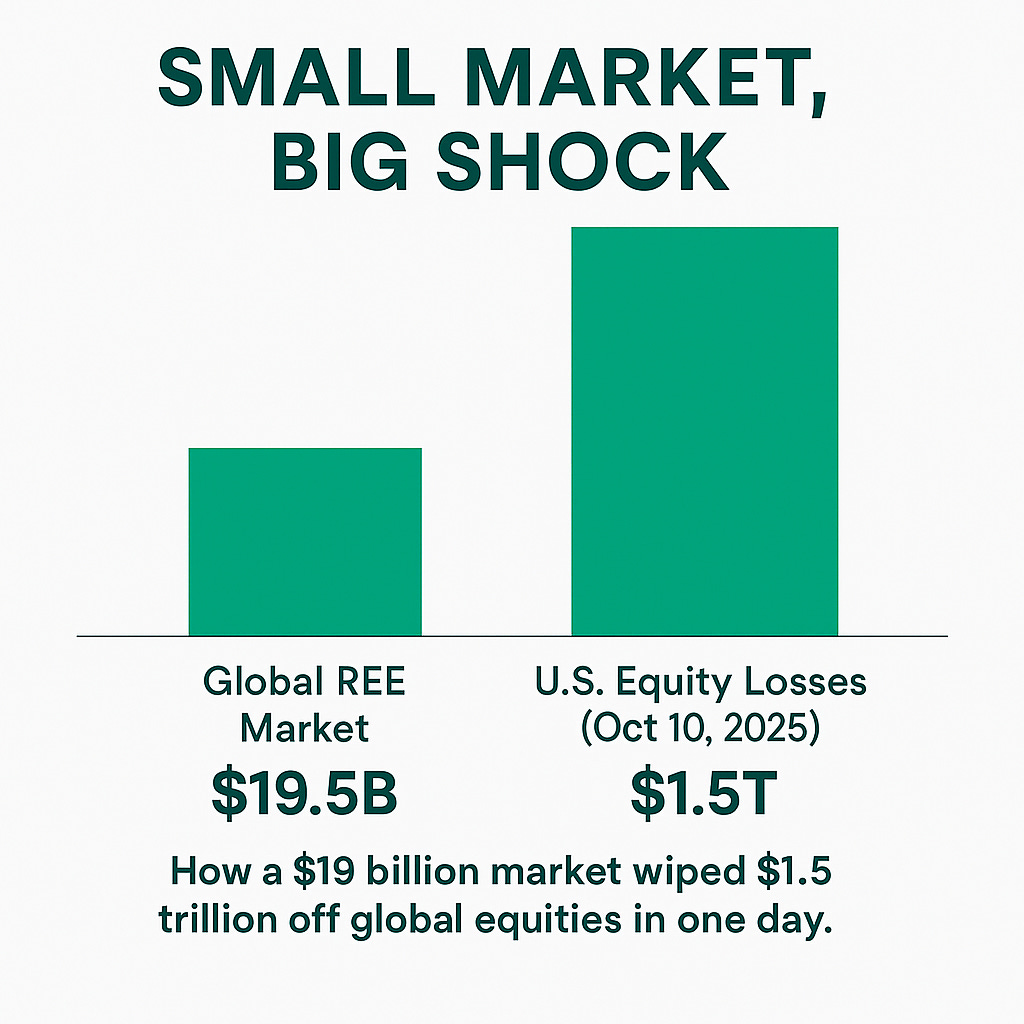No Surprise, It's Elemental
The Middle East has oil; China has rare earths–Deng Xiaoping, 1992
Reading time: 10 minutes
Editor’s Note
🕊️ This analysis coincides with the launch of the Hale Strategic Resources Initiative, a new non-profit research effort dedicated to mapping the geopolitical, environmental, and technological dimensions of resource security and how cooperation can prevent crises in both manufacturing and defense.
Overview
A small market, big reaction: The entire global rare earth market is only $19.5 billion, yet Friday’s equity losses erased $1.5 trillion in value—despite progress towards peace in the Middle East.
Symbolic leverage: China’s new export controls (Notice 61) triggered psychological contagion: fear outweighed actual trade exposure.
Strategic mirroring: Beijing’s move followed its quiet success in cutting US helium dependence from over 50% in 2022 to under 5% today.
Opportunity ahead: The US, in close cooperation with its allies, can turn this crisis into a Manhattan Project for materials to build supply chain resilience.
A Tiny Market, A Big Panic
The market for rare earths is surprisingly small.1 The US imported only $170 million of these special commodities from China last year.2 Yet the announcement of new export restrictions, Notice 2025 No. 61, issued on October 9 by the Ministry of Commerce, triggered one of Wall Street’s biggest sell-offs: $1.5 trillion in equity losses. At the same time, US-listed rare earth firms gained some $33 billion in market capitalization, despite of the fact that the value of the entire global rare earths market is only $19.5 billion.
Obviously, it is not just about price, but availability, given the critical role these niche metals play in global supply chains and the rivalry between the US and China. Why didn’t the US do more about this sooner? The small size of the rare earth market explains why the private sector in the US delayed investment for so long, and why government intervention might be necessary to kickstart it now.
In the meantime, the US has been taking steps to ameliorate risk:
The Financial Times reported that the Pentagon is spending $1 billion stockpiling critical minerals, treating supply chains as infrastructure, not inputs. However, stockpiling will tighten markets that are already tight.3
The private sector has been preparing as well. According to the Wall Street Journal, General Motors took a calculated risk in 2021 to produce rare-earth magnets for its automotive production line.4
❝ As a result, in the coming months, GM is now set to be the only US automaker with a large direct supply of American-made rare earth magnets from multiple factories.
Not all companies have joined in—yet. Ford, for example, had to close down production at its Illinois plant in May because of a shortage of the magnets.
Pax Sinica: The Big Picture
University of Chicago political science professor Dali Yang has a broader take on the geopolitical ramifications of China’s recent actions. As he wrote on X:
❝ In tightening export controls on rare earths, Beijing insists it isn’t “weaponizing supply,” only “regulating for security.” Yet the move marks a decisive moment: China has shown its hand for what Pax Sinica looks like—an order where gatekeeping over strategic materials and technologies underwrites global influence.
Short-term calm may follow Beijing’s reassurance, but the long-term effect is the opposite: it sharpens every nation’s resolve to de-risk. The new regime is not just about rare earths; it’s about the architecture of control—licensing, end-use review, and discretionary denial that can extend far beyond minerals to magnets, chips, batteries, and beyond.
China is effectively saying: “We control the arteries of high-tech civilization.” The rest of the world now sees that message clearly—and is scrambling to build new circulatory systems.
And indeed the reaction has been swift. This week JPMorgan Chase has announced a $1.5 trillion fund to boost critical industries. 5 Treasury Secretary Scott Bessent angrily called China’s moves a “miscalculation” before an expected summit between the leaders of the two countries later this month.
And not to forget, US farmers have not sold a single soybean to China in 2025. In 2024, half of their output was exported to China. This was obviously directed by Beijing.
Chatham House Warning
China watchers and research institutes such as Chatham House have long predicted the current debacle over critical minerals—the very definition of a gray rhino. Even if China backs down on its threat to block rare earth exports to the US, it has raised the specter of doubt which will now overhang all transactions with US customers—and others as well, influencing new global supply chains.
In addition to processing, China also dominates the market for mining and chemical processing technologies:
❝ Beijing’s new rules stipulate that licenses will be required for the export of technologies used in rare-earth mining and processing, as well as for the manufacturing of magnets… Crucially, any foreign firm that wants to supply rare earths produced in China or processed with Chinese technologies outside China will also need to get a license.
—James Kynge, Chatham House, Oct 20256
Sensing that they just might have overstepped, China’s Commerce Ministry hastened to clarify that rare earth export controls “do not amount to a ban” and that “all eligible applications will continue to receive licenses.” Still, the threat could reemerge at any time.

Licensing as Leverage
Keep reading with a 7-day free trial
Subscribe to econVue to keep reading this post and get 7 days of free access to the full post archives.



